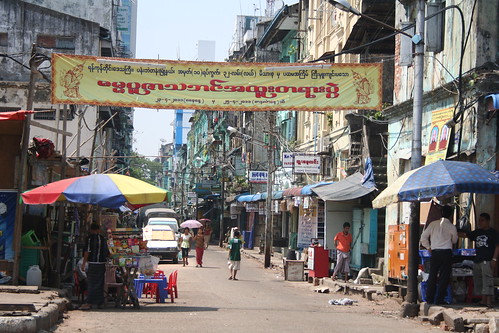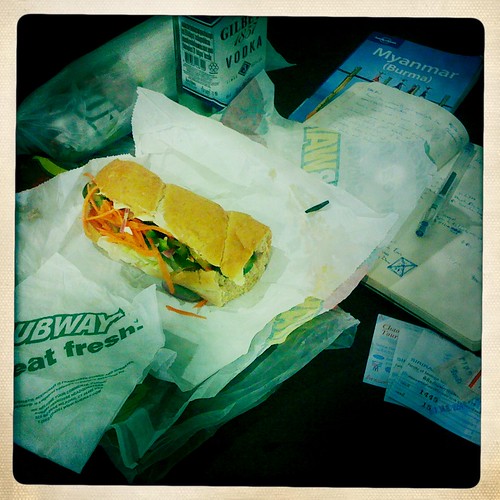
|
|
blindingly Bagan stupa plain, originally uploaded by Mister Wind-Up Bird. |
A thousand years ago, Bagan emerged as a place for rich and powerful Buddhist royals to build brick religious monuments to accrue enough merit to counter the misdeeds that made them rich and powerful. Today, it is a stunning monument to religious zeal—a huge, dusty plain with literally thousands of paya as far as the eye can see.
Bagan has a few more Western tourists than we saw in Yangon, as would be expected at the country’s biggest tourist attraction. Enough, at least, that you don’t get stared at in the street. But by far the biggest tourist contingent was Burmese taking advantage of the Thingyan holiday to visit the sites and pay respects at the many still-active temples.
We hired a covered horsecart and English-speaking driver for a day to take us around the pagodas. While a romantic way to see the sites, it’s also the most practical way to do it. There are only a few roughly-sealed roads to take the Chinese package tour buses to the main highlights. The rest of Bagan is rutted, dusty trails too rough for anything except horses, and the occasional cyclist willing to brave the 40-degree heat. In fact, horsecarts (and oxcarts) are widely used all over rural Burma for short hauls. While charming, they are also a reminder of how poor the countryside is. People here can only dream of the gleaming Japanese pickups farmers in neighboring Thailand have.
The highlight of Bagan is definitely climbing to the tops of the largest monuments at sunrise and sunset to take in the sheer scale of it all: red brick paya to the horizon in every direction, shrouded in the morning mist, or lit up red and gold in the setting sun. In between, we toured some of the temples, but they are much less elaborate and impressive individually than, say, Angkor. They are all laid out in a square floorplan, with four big Buddha statues, four prayer areas, four collection boxes and four gates. After a while, I found myself making mental notes on the more interesting floor tile variants. It’s really the sheer volume of monuments—over three thousand stupas, pagodas, temples and monasteries—that blows you away.
Like Angkor, there are folks at many sites looking to sell you things or provide services. Unlike Angkor, though, you can’t just push past them and let them go onto the next tourist: there might not be a next tourist for hours, so they have all the time in the world work on you. It’s really not so bad, though, once you give in and go with the flow. They are very sweet and provide actual services. We had one woman insist on applying thanaka sunscreen/makeup to us (“he look like baby!” she laughed after smearing it on my cheeks and nose), we had an old man show us the best camera angles and hidden details of a pagoda, and a young boy with a flashlight guided us through a dark monastery to the roof to see the sunset. We didn’t ask, and a little money was expected, but they were all very nice and polite about it, so we went along with it. Just easier that way. Travel in Asia is sometimes about picking your battles.
The heat was a lot harder to make peace with. An irritant in Yangon, by the time we got to Bagan the thermometer was on the wrong side of 40 degrees and stepping out of the shade was like opening an oven. This was our first real experience with intense Asian heat, and it made us think seriously about our traveling strategy. As willing as the spirit may be, when it gets this hot, everything becomes 30% to 60% less enjoyable: siteseeing, walking, eating, drinking; you name it, it’s impacted, and more than you might expect. We want to go to India, but May is the hottest month in most of the country, so some planning is in order (we decided to go to Laos next, anyway, so we’ll figure out India from there). Even in the short term: we considered going to historic Mandalay, but a check of the weather forecast (39 to 42 degrees for the following week) coupled with our limited interest in looking at yet more old Asian buildings, and we decided to pay a visit to more-temperate Inle Lake instead.
Turned out to be the right decision.


